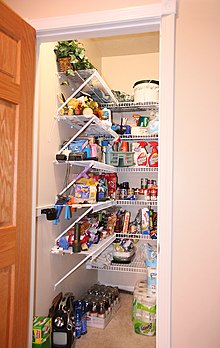
A pantry is a room or cupboard where beverages, food, (sometimes) dishes, household cleaning products, linens or provisions are stored within a home or office. Food and beverage pantries serve in an ancillary capacity to the kitchen.

A pantry is a room or cupboard where beverages, food, (sometimes) dishes, household cleaning products, linens or provisions are stored within a home or office. Food and beverage pantries serve in an ancillary capacity to the kitchen.
The word "pantry" derives from the same source as the Old French term paneterie ; that is from pain, the French form of the Latin panis, "bread". [1]
In a late medieval hall, there were separate rooms for the various service functions and food storage. The pantry was a dry room where bread was kept and food preparation was done. The head of the office who is responsible for this room is referred to as a pantler. There were similar rooms for cooler storage of meats and lard/butter (larder), alcoholic beverages (buttery, known for the "butts", or barrels, stored there), and cooking (kitchen).

In the United States, pantries evolved from early Colonial American "butteries", built in a cold north corner of a colonial home (more commonly referred to and spelled as "butt'ry"), into a variety of pantries in self-sufficient farmsteads. Butler's pantries, or China pantries, were built between the dining room and kitchen of a middle-class English or American home, especially in the latter part of the 19th into the early 20th centuries. Great estates, such as the Biltmore Estate in Asheville, North Carolina or Stan Hywet Hall in Akron, Ohio, had many pantries and other domestic "offices", echoing their British "great house" counterparts.
By the Victorian era, large houses and estates in Britain maintained the use of separate rooms, each one dedicated to distinct stages of food preparation and cleanup. The kitchen was for cooking, while food was stored in a storeroom, pantry or cellar. Meat preparation was done in a larder as game would come in undressed, fish unfilleted, and meat in half or quarter carcasses. Vegetable cleaning and preparation would be done in the scullery. Dishwashing was done in a scullery or butler's pantry, "depending on the type of dish and level of dirt". [2]
Since the scullery was the room with running water with a sink, it was where the messiest food preparation took place, such as cleaning fish and cutting raw meat. The pantry was where tableware was stored, such as China, glassware, and silverware. If the pantry had a sink for washing tableware, it was a wooden sink lined with lead to prevent chipping the China and glassware while they were being washed. In some middle-class houses, the larder, pantry, and storeroom might simply be large wooden cupboards, each with its exclusive purpose. [3]
Traditionally, kitchens in Asia [ where? ] have been more open format than those of the West. The function of the pantry was generally served by wooden cabinetry. For example, in Japan, a kitchen cabinet is called a "mizuya tansu". A substantial tradition of woodworking and cabinetry in general developed in Japan, especially throughout the Tokugawa period. A huge number of designs for tansu (chests or cabinets) were made, each tailored towards one specific purpose or another.
The idea is very similar to that of the Hoosier cabinet, with a wide variety of functions being served by specific design innovations.

A butler's pantry or serving pantry is a utility room in a large house, primarily used to store serving items, rather than food. Traditionally, a butler's pantry was used for cleaning, counting, and storage of silver. European butlers often slept in the pantry, as their job was to keep the silver under lock and key. The merchant's account books and wine log may also have been kept in there. The room would be used by the butler and other domestic staff. Even in households where there is no butller, it is often called a butler's pantry.[ citation needed ] [4]
In modern houses, butler's pantries are usually located in transitional spaces between kitchens and dining rooms and are used as staging areas for serving meals. They commonly contain countertops, as well as storage for candles, serving pieces, table linens, tableware, wine, and other dining room articles. More elaborate versions may include dishwashers, refrigerators, or sinks.[ citation needed ]
Butler's pantries have become popular in recent times. [5]

Certain foods, such as butter, eggs, and milk, need to be kept cool [6] . Before modern refrigeration was available, iceboxes were popular. However, the problem with an icebox was that the cabinet housing it was large, but the actual refrigerated space was relatively small. A clever and innovative solution was invented, the "cold pantry", sometimes called a "California cooler." [7] The cold pantry usually consisted of a cabinet or cupboard with wooden-slat shelves for air circulation. An opening near the top vented to the outside, either through the roof or high out the wall. A second opening near the bottom vented also to the outside, but low near the ground and usually on the north side of the house, where the air was cooler. As the air in the pantry warmed, it rose, escaping through the upper vent. This in turn drew cooler air in from the lower vent, providing constant circulation of cooler air. In the summertime, the temperature in the cold pantry would usually hover several degrees lower than the ambient temperature in the house, while in the wintertime, the temperature in the cold pantry would be considerably lower than that in the house.

A cold pantry was the perfect place to keep food stocks that did not necessarily need to be kept refrigerated. Breads, butter, cheesecakes, eggs, pastries, and pie were the common food stocks kept in a cold pantry. Vegetables could be brought up from the root cellar in smaller amounts and stored in the cold pantry until ready to use. With space in the icebox at a premium, the cold pantry was a great place to store fresh berries and fruit.
First developed in the early 1900s by the Hoosier Manufacturing Company in New Castle, Indiana, and popular into the 1930s, the Hoosier cabinet and its many imitators soon became an essential fixture in American kitchens. Often billed as a "pantry and kitchen in one", the Hoosier brought the ease and readiness of a pantry, with its many storage spaces and working counter, right into the kitchen. It was sold in catalogues and through a unique sales program geared towards farm wives. Today, the Hoosier cabinet is a much sought-after domestic icon and widely reproduced.[ citation needed ]
This section's tone or style may not reflect the encyclopedic tone used on Wikipedia.(May 2010) |
Chapters of earlier books, particularly written during the era of domestic science and home economics in the latter half of the 19th century, featured how to furnish, keep, and clean a pantry. Catharine E. Beecher and Harriet Beecher Stowe, in their seminal The American Woman's Home (1869), [8] advocated the elimination of the pantry by installing pantry shelving and cabinetry in the kitchen. This idea did not take hold in American households until a century later, by which time the pantry had become a floor-to-ceiling cabinet in the Post-Vietnam War kitchen[ citation needed ]. During the Victorian era and until the Second World War, when housing changed considerably, pantries were commonplace in virtually all American homes. This was because kitchens were small and strictly utilitarian, and not the domestic center of the home.[ citation needed ] Thus, pantries were important workspaces with their built-in shelving, cupboards and countertops.
In the last chapter of These Happy Golden Years, Laura Ingalls Wilder wrote a descriptive account of the pantry that Almanzo Wilder built for her in their first home together in DeSmet, South Dakota. It details a working farmhouse pantry in great detail, which she sees for the first time after her marriage to Wilder and subsequent journey to their new home. [9]
Pantry raids were often common themes in children's literature and early 20th century advertising. Perhaps the most famous pantry incident in literature was when Mark Twain's Tom Sawyer had to do penance for getting into his Aunt Polly's jam in her pantry: as punishment, he had to whitewash her fence. [10]
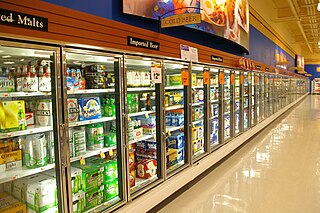
Refrigeration is any of various types of cooling of a space, substance, or system to lower and/or maintain its temperature below the ambient one. Refrigeration is an artificial, or human-made, cooling method.

A closet is an enclosed space, with a door, used for storage, particularly that of clothes. Fitted closets are built into the walls of the house so that they take up no apparent space in the room. Closets are often built under stairs, thereby using awkward space that would otherwise go unused.

A kitchen is a room or part of a room used for cooking and food preparation in a dwelling or in a commercial establishment. A modern middle-class residential kitchen is typically equipped with a stove, a sink with hot and cold running water, a refrigerator, and worktops and kitchen cabinets arranged according to a modular design. Many households have a microwave oven, a dishwasher, and other electric appliances. The main functions of a kitchen are to store, prepare and cook food. The room or area may also be used for dining, entertaining and laundry. The design and construction of kitchens is a huge market all over the world.
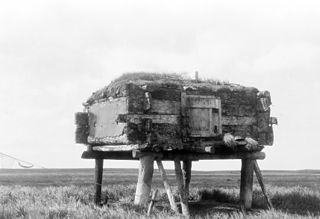
Food storage is a way of decreasing the variability of the food supply in the face of natural, inevitable variability. It allows food to be eaten for some time after harvest rather than solely immediately. It is both a traditional domestic skill and, in the form of food logistics, an important industrial and commercial activity. Food preservation, storage, and transport, including timely delivery to consumers, are important to food security, especially for the majority of people throughout the world who rely on others to produce their food.
The Japanese kitchen is the place where food is prepared in a Japanese house. Until the Meiji era, a kitchen was also called kamado and there are many sayings in the Japanese language that involve kamado as it was considered the symbol of a house. The term could even be used to mean "family" or "household". Separating a family was called kamado wo wakeru, or "divide the stove". Kamado wo yaburu means that the family was broken.

A refrigerator, colloquially fridge, is a commercial and home appliance consisting of a thermally insulated compartment and a heat pump that transfers heat from its inside to its external environment so that its inside is cooled to a temperature below the room temperature. Refrigeration is an essential food storage technique around the world. The low
temperature lowers the reproduction rate of bacteria, so the refrigerator reduces the rate of spoilage. A refrigerator maintains a temperature a few degrees above the freezing point of water. The optimal temperature range for perishable food storage is 3 to 5 °C. A similar device that maintains a temperature below the freezing point of water is called a freezer. The refrigerator replaced the icebox, which had been a common household appliance for almost a century and a half. The United States Food and Drug Administration recommends that the refrigerator be kept at or below 4 °C (40 °F) and that the freezer be regulated at −18 °C (0 °F).

A larder is a cool area for storing food prior to use. Originally, it was where raw meat was larded—covered in fat—to be preserved. By the 18th century, the term had expanded: at that point, a dry larder was where bread, pastry, milk, butter, or cooked meats were stored. Larders were commonplace in houses before the widespread use of the refrigerator.

A scullery is a room in a house, traditionally used for washing up dishes and laundering clothes, or as an overflow kitchen. Tasks performed in the scullery include cleaning dishes and cooking utensils, occasional kitchen work, ironing, boiling water for cooking or bathing, and soaking and washing clothes. Sculleries contain hot and cold sinks, sometimes slop sinks, drain pipes, storage shelves, plate racks, a work table, various coppers for boiling water, tubs, and buckets.
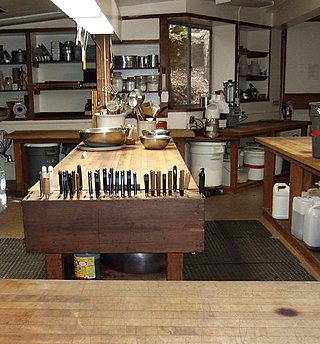
Kitchen cabinets are the built-in furniture installed in many kitchens for storage of food, cooking equipment, and often silverware and dishes for table service. Appliances such as refrigerators, dishwashers, and ovens are often integrated into kitchen cabinetry. There are many options for cabinets available at present.

An icebox is a compact non-mechanical refrigerator which was a common early-twentieth-century kitchen appliance before the development of safely powered refrigeration devices. Before the development of electric refrigerators, iceboxes were referred to by the public as "refrigerators". Only after the invention of the modern electric refrigerator did early non-electric refrigerators become known as iceboxes. The terms ice box and refrigerator were used interchangeably in advertising as long ago as 1848.

A garde manger is a cool, well-ventilated area where cold dishes are prepared and other foods are stored under refrigeration. The person in charge of this area is known as the "chef garde manger" or "pantry chef". Larger hotels and restaurants may have garde manger staff to perform additional duties, such as creating decorative elements of buffet presentation like ice carving and edible centerpieces.
A utility room is a room within a house where equipment not used in day-to-day activities is kept. "Utility" refers to an item which is designed for usefulness or practical use, so in turn most of the items kept in this room have functional attributes. A utility room is generally the area where laundry is done, and is the descendant of the scullery.

A Hoosier cabinet or Hoosier is a type of cupboard or free-standing kitchen cabinet that also serves as a workstation. It was popular in the first few decades of the 20th century in the United States, since most houses did not have built-in kitchen cabinetry. The Hoosier Manufacturing Co. of New Castle, Indiana, was one of the earliest and largest manufacturers of this product, causing the term "Hoosier cabinet" to become a generic term for that type of furniture. By 1920, the Hoosier Manufacturing Company had sold two million cabinets.

A Welsh dresser or a china hutch, sometimes known as a kitchen dresser or pewter cupboard, is a piece of wooden furniture consisting of drawers and cupboards in the lower part, with shelves and perhaps a sideboard on top. Traditionally, it is a utilitarian piece of furniture used to store and display crockery, silverware and pewter-ware, but is also used to display general ornaments.
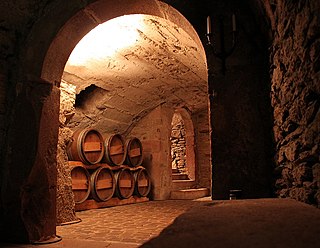
A buttery was originally a large cellar room under a monastery, in which food and drink were stored for the provisioning of strangers and passing guests. Nathan Bailey's An Universal Etymological English Dictionary gives "CELLARIST – one who keeps a Cella, or Buttery; the Butler in a religious House or Monastery." As the definition in John Stevens's The History of the Antient Abbeys shows, its initial function was to feed and water the guests rather than monks: "The Buttery; the Lodging for Guests". In a monastery a buttery was thus the place from which travellers would seek 'doles' of bread and weak ale, given at the exterior buttery door. The task of doling out this free food and drink would be the role of the butterer. At larger monasteries there would also be a basic hostelry, where travellers could sleep for free.
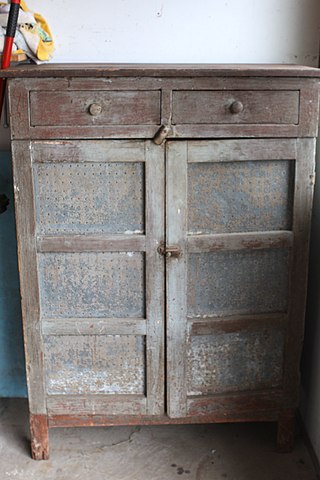
A pie safe, also called a pie chest, pie cupboard, kitchen safe, and meat safe, is a piece of furniture designed to store pies and other food items. This was a normal household item before iceboxes came into regular use, and it was an important part of the American household starting in the 1700s and continuing through the 1800s.

A game larder, also sometimes known as a deer or venison larder, deer, venison or game house, game pantry or game store, is a small domestic outbuilding where the carcasses of game, including deer, game birds, hares and rabbits, are hung to mature in a cool environment. A feature of large country houses and sporting lodges in Britain and parts of northern Europe from the 18th century, game larders continue to be used by shooting estates.
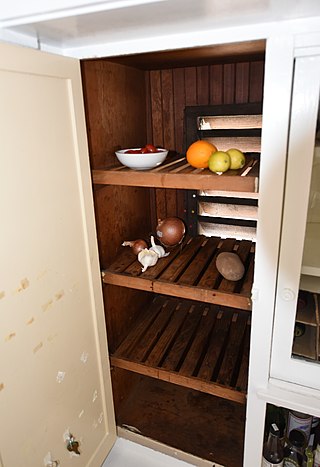
A California cooler, also known as a cooler cabinet, is a type of cabinet used for the cool storage of food items that was popular in the western United States, in the late 19th and early 20th century.
Porcelain services that were produced during the Rococo period, roughly aligning with the reign of Louis XV of France from 1715 to 1774, included a variety of shapes or molds of dishes for use during savory and sweetmeat courses. These included plates, platters, tureens, sauce cups, cake stands, epergnes, wine coolers, and ice cream coolers, as well as porcelain molds not designed for food services such as etagere vases, flower vases, potpourri vases, toilet set bowls, and plaques inlaid into furniture. Two of the most famous manufacturers of rococo porcelain services in Europe were the Manufacture Nationale de Sevres in France and Meissen Porcelain in Germany. While Sevres worked almost exclusively in soft paste porcelain during the rococo period, which was composed of a translucent mixture of clay, glass, and minerals such as feldspar and quartz, Meissen was the first European porcelain manufactory to produce hard paste wares, which were modeled after earlier Asian imported porcelain which contained clay, minerals, and kaolin, which allowed the clay to survive much higher firing temperatures in the kiln, producing more opaque and stronger completed dishes than were previously available domestically.